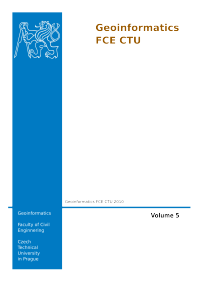Modern Algorithms for Real-Time Terrain Visualization on Commodity Hardware
DOI:
https://doi.org/10.14311/gi.5.1Keywords:
computer graphics, rendering, real-time, level of detail, out-of-core, DEM, heightmapAbstract
The amount of input data acquired from a remote sensing equipment is rapidly growing. Interactive visualization of those datasets is a necessity for their correct interpretation. With the ability of modern hardware to display hundreds of millions of triangles per second, it is possible to visualize the massive terrains at one pixel display error on HD displays with interactive frame rates when batched rendering is applied. Algorithms able to do this are an area of intensive research and a topic of this article. The paper first explains some of the theory around the terrain visualization, categorizes its algorithms according to several criteria and describes six of the most significant methods in more details.References
Jet Propulsion Laboratory, California Institute of Technology, ”Shuttle radar topography mission”, July 2010. Available at: http://www2.jpl.nasa.gov/srtm/
Earth Remote Sensing Data Analysis Center, ”ASTER GDEM”, July 2010. Available at http://www.gdem.aster.ersdac.or.jp
R. Pajarola, ”Large scale terrain visualization using the restricted quadtree triangulation”, Proceedings of the Conference on Visualization ’98, pp. 19–26, IEEE Computer Society Press Los Alamitos, CA, USA, 1998.
R. Pajarola, M. Antonijuan and R. Lario, ”QuadTIN: quadtree based triangulated irregular networks”, VIS ’02: Proceedings of the Conference on Visualization ’02, pp. 395–402, 2002.
L. M. Hwa, M. A. Duchaineau and K. I. Joy, ”Real-time optimal adaptation for planetary geometry and texture: 4-8 tile hierarchies,” IEEE Transactions on Visualization and Computer Graphics, vol. 11, no. 4, pp. 355–368, 2005.
M. A. Duchaineau, M. Wolinsky, D. E. Sigeti, M. C. Miller, M. B. Mineev-Weinstein and C. Aldrich, ”ROAMing terrain: Real-time optimally adapting meshes”, IEEE Visualization, pp. 81–88, 1997.
A. A. Pomeranz, ”Roam using surface triangle clusters (RUSTiC)”. Diploma thesis, University of California at Davis, 2000.
W. Evans, D. Kirkpatrick and G. Townsend, ”Right triangular irregular networks”, University of Arizona, Tucson, AZ, USA, 1997.
W. Evans, D. Kirkpatrick and G. Townsend, ”Right-triangulated irregular networks”, Algorithmica, vol. 30, no. 2, pp. 264–286, 2001.
W. H. de Boer, ”Fast terrain rendering using geometrical mipmapping”, 2000. Available at: http://www.flipcode.com/articles/article geomipmaps.pdf
E. Poyart, P. Frederick, R. D. B. Seixas and M. Gattass, ”Simple real-time flight over arbitrary-sized terrains,” Workshop Brasileiro de GeoInformatica, p. 5, Citeseer, 2002.
D. Wagner, ”Terrain geomorphing in the vertex shader”, ShaderX2, Shader Programming Tips and Tricks, pp. 1–12, 2003.
B. D. Larsen and N. J. Christensen, ”Real-time terrain rendering using smooth hardware optimized level of detail”, Journal of WSCG, vol. 11, no. 1, p. 8, 2003.
J. Pouderoux and J. Marvie, ”Adaptive streaming and rendering of large terrains using strip masks”, Proceedings of the 3rd International Conference on Computer Graphics and Interactive Techniques in Australasia and South East Asia, p. 306, 2005.
J. Schneider and R. Westermann, ”GPU-friendly high-quality terrain rendering”, Journal of WSCG, vol. 14, no. 1-3, pp. 49–56, 2006.
T. Ulrich, ”Rendering massive terrains using chunked level of detail control”, SIGGRAPH Course Notes, vol. 3, no. 5, 2002.
F. Losasso and H. Hoppe, ”Geometry clipmaps: terrain rendering using nested regular grids”, International Conference on Computer Graphics and Interactive Techniques, pp. 769–776, ACM New York, NY, USA, 2004.
A. Asirvatham and H. Hoppe, ”Terrain rendering using GPU-based geometry clipmaps”, GPU Gems, vol. 2, no. 2, pp. 27–46, 2005.
C. C. Tanner, C. J. Migdal and M. T. Jones, ”The clipmap: a virtual mipmap”, Proceedings of the 25th Annual Conference on Computer Graphics and Interactive Techniques, pp. 151–158, ACM New York, NY, USA, 1998.
USGS and The University of Washington, ”Puget sound terrain”, July 2010. Available at: http://www.cc.gatech.edu/projects/large models/ps.html
M. Clasen and H.-C. Hege, ”Terrain rendering using spherical clipmaps”, Eurographics/IEEE-VGTC Symposium on Visualization (T. Ertl, K. Joy, and B. Santos, eds.), 2006.
P. Cignoni, F. Ganovelli, E. Gobbetti, F. Marton, F. Ponchio and R. Scopigno, ”BDAM – batched dynamic adaptive meshes for high performance terrain visualization”, Computer Graphics Forum, vol. 22, pp. 505–514, Sept. 2003.
P. Cignoni, F. Ganovelli, E. Gobbetti, F. Marton, F. Ponchio and R. Scopigno, ”Planetsized batched dynamic adaptive meshes (P-BDAM)”, IEEE Transactions on Ultrasonics, Ferroelectrics and Frequency Control, pp. 147–154, 2003.
E. Gobbetti, P. Cignoni, F. Ganovelli, F. Marton, F. Ponchio and R. Scopigno, ”Interactive out-of-core visualisation of very large landscapes on commodity graphics platform”, Lecture Notes in Computer Science, pp. 21–29, 2003.
E. Gobbetti, F. Marton, P. Cignoni, M. Di Benedetto and F. Ganovelli, ”C-BDAM – compressed batched dynamic adaptive meshes for terrain rendering”, Computer Graphics Forum, vol. 25, pp. 333–342, Sept. 2006.
Y. Livny, Z. Kogan and J. El-Sana, ”Seamless patches for GPU-based terrain rendering”, The Visual Computer, vol. 25, pp. 197–208, Mar. 2008.
Downloads
Published
Issue
Section
License
- Authors retain copyright and grant the journal right of first publication with the work simultaneously licensed under a Creative Commons Attribution License that allows others to share the work with an acknowledgement of the work's authorship and initial publication in this journal.
- Authors are able to enter into separate, additional contractual arrangements for the non-exclusive distribution of the journal's published version of the work (e.g., post it to an institutional repository or publish it in a book), with an acknowledgement of its initial publication in this journal.
- Authors are permitted and encouraged to post their work online (e.g., in institutional repositories or on their website) prior to and during the submission process, as it can lead to productive exchanges, as well as earlier and greater citation of published work (See The Effect of Open Access).

